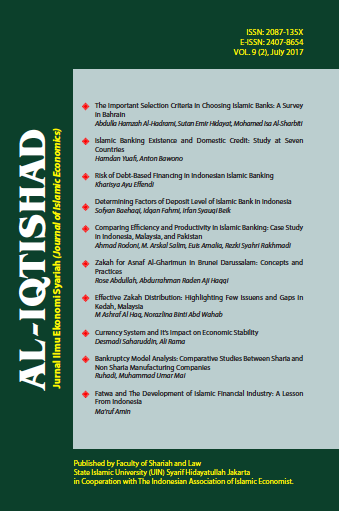Comparing Efficiency and Productivity in Islamic Banking : Case Study Indonesia, Malaysia and Pakistan
DOI:
https://doi.org/10.15408/aiq.v9i2.5153Keywords:
data envelopment analysis, efficiency, malmquist index, productivityAbstract
The objective of this research is to analyze both efficiency and productivity of Islamic Banking Industry in Indonesia, Malaysia and Pakistan. The technique that used in this research is Data Envelopment Analysis (DEA) as for measuring efficiency and thus Malmquist Index (MI) as for measuring productivity. The result of this research found that Islamic Banking Industry in Indonesia is facing inefficiency that shown by five years average that is not reach 100% efficiency rate. Malaysia also experiences the problem of inefficiency but the condition is better compared to Indonesia. In five years, the efficiency rate of Malaysia Islamic Bank has not reach 100% efficiency rate. Pakistan among the closest country that could reach an efficient rate level for their Islamic banks. Pakistan close to reach 100% efficient rate within the last five years.
DOI: 10.15408/aiq.v9i2.5153References
Ahmed, U. et.al. (2009). Efficiency Dynamics and Financial Reforms: Case Study of Pakistani Banks. International Research Journal of Finance and Economics, 25: 172-182.
Berger, A.N. et.al. (2007). Bank Ownership and Efficiency in China: What Lies Ahead in The World`s Largest Nation? Bank of Finland Research Discussion Papers 16.
Ellahi, N. (2011). Testing Technical and Cost Efficiency of Pakistani Islamic Banking System, “ 8th International Conference on Islamic Economics and Finance. Qatar Faculty of Islamic Studies.
Hassan, M.K. (2006). The X-Efficiency in Islamic Banks. Islamic Economic Studies, 13 (2): 49-78.
Hossen, M.N. & R. Rahmawati. (2016). Efficiency and Profitability on Indonesian Islamic Banking Industry. Al-Iqtishad: Jurnal Ilmu Ekonomi Syariah (Journal of Islamic Economics), 8 (1): 33-48.
Indrawati. Y. (2009). Analisis Efisiensi Bank Umum di Indonesia Periode 2004 – 2007: Aplikasi Metode Data Envelopment Analysis (DEA). (Unpublished Thesis). Depok: Universitas Indonesia.
Jajri, I. (2008).Contribution of Technical Change to Output Growth in Small and Medium Scale Industries: Evidence from Malaysia. Global Economy and Finance Journal, 1 (1): 56-65.
Luciano, E. & L. Regis. (2007). Bank Efficiency and Banking Sector Development: the Case of Italy. ICER Working Paper.
Mediadianto, A. (2007), Efisiensi Bank Syariah dan Bank Konvensional dengan Metode DEA. (Unpublished Thesis). Depok: Universitas Indonesia.
Mghaieth, A. & I.K. El Mehdi. (2014). The Determinants of Cost/Profit Efficiency of Islamic Banks Before, During, and After The Crisisi of 2007-2008 using SFA Approach. (Working Paper). IPAG Business School.
Mohamad, S. et.al. (2008). Efficiency of Conventional versus Islamic Banks: International Evidence using the Stochastic Frontier Approach (SFA). Journal of Islamic Economics, Banking and Finance. 107-130.
Setiawan. I. (2007). Analisa Perbankan Indonesia dengan Menggunakan Metode Data Envelopment Analasis Studi Kasus 25 Bank dengan DPK Terbesar Tahun 2001 – 2005. (Unpublished Thesis). Depok: Universitas Indonesia.
Sufian, F. (2007). Malmquist Indices of Productivity Change In Malaysian Islamic Banking Industry: Foreign Versus Domestic Banks. Journal of Economic Cooperation, 28 (1): 115-150.
Yudistira, D. (2004). Efficiency in Islamic Banking: An Empirical Analysis of Eighteen Banks. Islamic Economic Studies, Vol 12 (1): 1-19.

